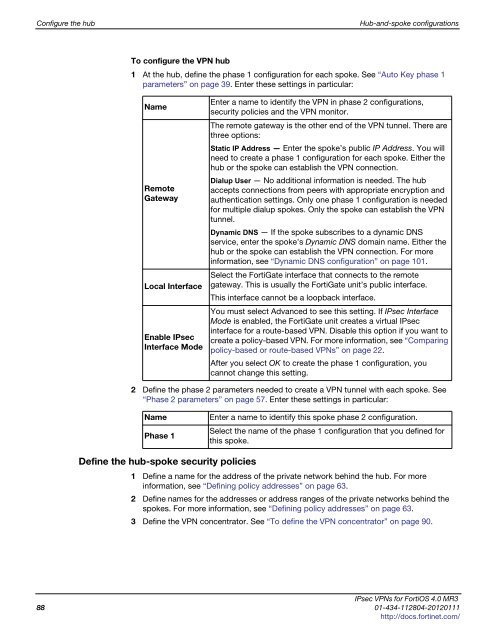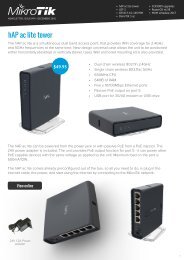fortigate-ipsec-40-mr3
fortigate-ipsec-40-mr3
fortigate-ipsec-40-mr3
You also want an ePaper? Increase the reach of your titles
YUMPU automatically turns print PDFs into web optimized ePapers that Google loves.
Configure the hub Hub-and-spoke configurations<br />
To configure the VPN hub<br />
1 At the hub, define the phase 1 configuration for each spoke. See “Auto Key phase 1<br />
parameters” on page 39. Enter these settings in particular:<br />
Name<br />
Remote<br />
Gateway<br />
Local Interface<br />
Enable IPsec<br />
Interface Mode<br />
2 Define the phase 2 parameters needed to create a VPN tunnel with each spoke. See<br />
“Phase 2 parameters” on page 57. Enter these settings in particular:<br />
Define the hub-spoke security policies<br />
Enter a name to identify the VPN in phase 2 configurations,<br />
security policies and the VPN monitor.<br />
The remote gateway is the other end of the VPN tunnel. There are<br />
three options:<br />
Static IP Address — Enter the spoke’s public IP Address. You will<br />
need to create a phase 1 configuration for each spoke. Either the<br />
hub or the spoke can establish the VPN connection.<br />
Dialup User — No additional information is needed. The hub<br />
accepts connections from peers with appropriate encryption and<br />
authentication settings. Only one phase 1 configuration is needed<br />
for multiple dialup spokes. Only the spoke can establish the VPN<br />
tunnel.<br />
Dynamic DNS — If the spoke subscribes to a dynamic DNS<br />
service, enter the spoke’s Dynamic DNS domain name. Either the<br />
hub or the spoke can establish the VPN connection. For more<br />
information, see “Dynamic DNS configuration” on page 101.<br />
Select the FortiGate interface that connects to the remote<br />
gateway. This is usually the FortiGate unit’s public interface.<br />
This interface cannot be a loopback interface.<br />
You must select Advanced to see this setting. If IPsec Interface<br />
Mode is enabled, the FortiGate unit creates a virtual IPsec<br />
interface for a route-based VPN. Disable this option if you want to<br />
create a policy-based VPN. For more information, see “Comparing<br />
policy-based or route-based VPNs” on page 22.<br />
After you select OK to create the phase 1 configuration, you<br />
cannot change this setting.<br />
Name Enter a name to identify this spoke phase 2 configuration.<br />
Phase 1<br />
Select the name of the phase 1 configuration that you defined for<br />
this spoke.<br />
1 Define a name for the address of the private network behind the hub. For more<br />
information, see “Defining policy addresses” on page 63.<br />
2 Define names for the addresses or address ranges of the private networks behind the<br />
spokes. For more information, see “Defining policy addresses” on page 63.<br />
3 Define the VPN concentrator. See “To define the VPN concentrator” on page 90.<br />
IPsec VPNs for FortiOS 4.0 MR3<br />
88 01-434-112804-20120111<br />
http://docs.fortinet.com/



